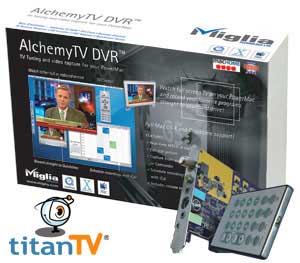"Beware MLMUG Tinkerors"
[ home | reviews | bylaws | library ]
|
View all our book reviews. Or, view our Software, hardware, and game reviews.
by Stan Horwitz
After months of searching for a high definition cable TV tuner for my Mac, I gave up because such a product does not exist. I still wanted to use my Mac as a video recorder. To the best of my knowledge, only three companies make products that do this: Elgato, Formac, and Miglia. Miglia is the only company who makes a PCI TV card. The other two companies make external TV tuners that connect to a Mac either via Firewire or USB. Elgato makes a Firewire HDTV tuner, but it uses broadcast TV and it is not compatible with any cable TV services; which is a deal breaker for me. The AlchemyTV DVR box includes the PCI card, DVR software and documentation on a CD-ROM disc, and a one-page installation document. A credit-card size remote control and a sensor to plug into the card are also included. A newer DVR version was available on Miglia's web site, which the printed directions referenced. Miglia's web site is easy to navigate to find information and downloadable files. Starting the DVR software for the first time requires entering an extremely long serial number. The AlchemyTV DVR card is compatible with any G4 and G5 Mac that has a free PCI or PCI-X slot and at least a 400Mhtz processor. Miglia recommends at least 256MB of RAM. The DVR software requires Mac OS X 10.2.4 or higher. The software will not work with OS 9. I am using my AlchemyTV DVR card with a dual processor 2.5Ghtz PowerMac G5 with 1GB of RAM, a external hard drive devoted to this purpose, and a previous generation 23" Apple Cinema Display. The card has inputs for a TV Antenna, Composite, S-Video, and stereo. I am using an analog cable TV connection, which allows me to view all the basic analog cable channels, but not the premium or pay-per-view channels. The S-Video and direct digital cable TV box connections do not allow the card to change channels independently, but they do provide better quality video, especially S-Video and you can receive all of your channels, including the digital ones. The list price for this package is $159, but I found it for $16 cheaper (including S&H) at J&R's Computer World. Full technical specifications are available on Miglia's web site. The Miglia TV card appealed to me for two reasons: it would not consume any desk space and its software integrates with iCal. I was also hoping to use my Palm Pilot to trigger the AlchemyTV card's DVR software to record television shows. Installing and getting my dual processor 2.5Ghtz Mac G5 to see the card was a simple process. The only tool I needed was a Philips head screwdriver in order to remove the metal dust cover from the PCI slot and fasten the card into the slot. Setting up the DVR software was extremely daunting. The documentation (in a pdf file) is very cryptic, but using most features is easy once the configuration is done. I found myself looking on Miglia's FAQ files on Miglia's web site quite a bit, but the FAQ files also contain errors. The card works well. There is some degradation of the picture quality due to my use of a cable modem and cable TV for the input signal, but the degradation is minor. The size of the TV screen is at most 640 x 480. On my monitor, a 640 x 480 Megapixel video image translates to approximately 6.5" x 4.5". Those who use QuickTime Pro can enlarge this image to approximately 20" x 9.5" on a 23" Cinema Display set at its highest resolution. Using the default video settings produces a 10GB file for a one-hour recording. This file plays in QuickTime, not the DVR software. A plug-in is available to allow recorded video files to play within the DVR software. Smaller file sizes are available by selecting options to save in more compressed formats. Extensive configuration options are available, even to the point of configuring different video and sound options for individual channels. Recording TV shows works much like a VCR. The DVR software offers a lot of options for scheduling recordings, and it maintains a log of what was recorded. The DVR software also seems to want to be turn off when a scheduled recording begin, just like every VCR I have ever owned. The TV card comes free with an on-line TV schedule service that works via a web browser, but it requires Internet service. This service is called Titan TV and it works well with the DVR software, although scheduling recordings is a bit cumbersome for Safari users because of Safari's security features. Each time you schedule a show via the Titan TV web page, it creates a file called program.tvpi. You need to double-click on this file in order to import the scheduled event into the DVR's TV schedule utility. The file disappears after it is activated. If you do not double-click the file, it will not overwrite the existing file. Instead, the Titan TV software will add a numerical designation onto each new file. These files are placed in the downloads folder that you designate through Safari's preferences. The biggest disappointment with the DVR software is its iCal integration. You can set up the TV recorder to output scheduled events to iCal and/or import scheduled events from iCal. Scheduling an event purely by using a Palm Pilot or just iCal itself is a difficult task and is prone to error. This is because each iCal entry has to follow a very precise format, and some information cannot be entered directly on a Palm Pilot as far as I can tell. I have not spent much time with the software so there may be a way to fix this problem. According to the documentation, the AchemyTV DVR card's remote control unit can control any Mac software, such as iTunes. Unfortunately, the remote control unit that was included in my package does not work, even with the DVR software. As such, all I can say is that configuring the remote control unit is done via a preferences panel. The preferences panel is very rudimentary. You have to configure every button on the remote control unit to perform a desired action by telling it which short-cut keys equate with that action. After you do this, the preferences panel creates a preference file, but not in your Library/Preferences directory. Instead, you need to manually move the file into its proper place, and it will supposedly work after that. After encountering problems configuring the DVR software and the issue with the broken remote control unit, I considered returning this package to get a refund, but I think I will keep it since it now does most of what I want. The lack of a remote control is not a deal breaker for me, although I did contact Miglia's customer support about it today (a Sunday) and I am awaiting a reply. Most of my distaste for this item comes from configuring it. The configuration process is far more difficult than it should be, mainly because of poor documentation. Once everything is configured, the DVR software and Titan TV work well.
This site has many more reviews, all written by MLMUG members.
[ home | newsletter | past | join | listserve | shareware | directory | links | md9 ] © 2005 by Stan Horwitz & MLMUG |
|||||

